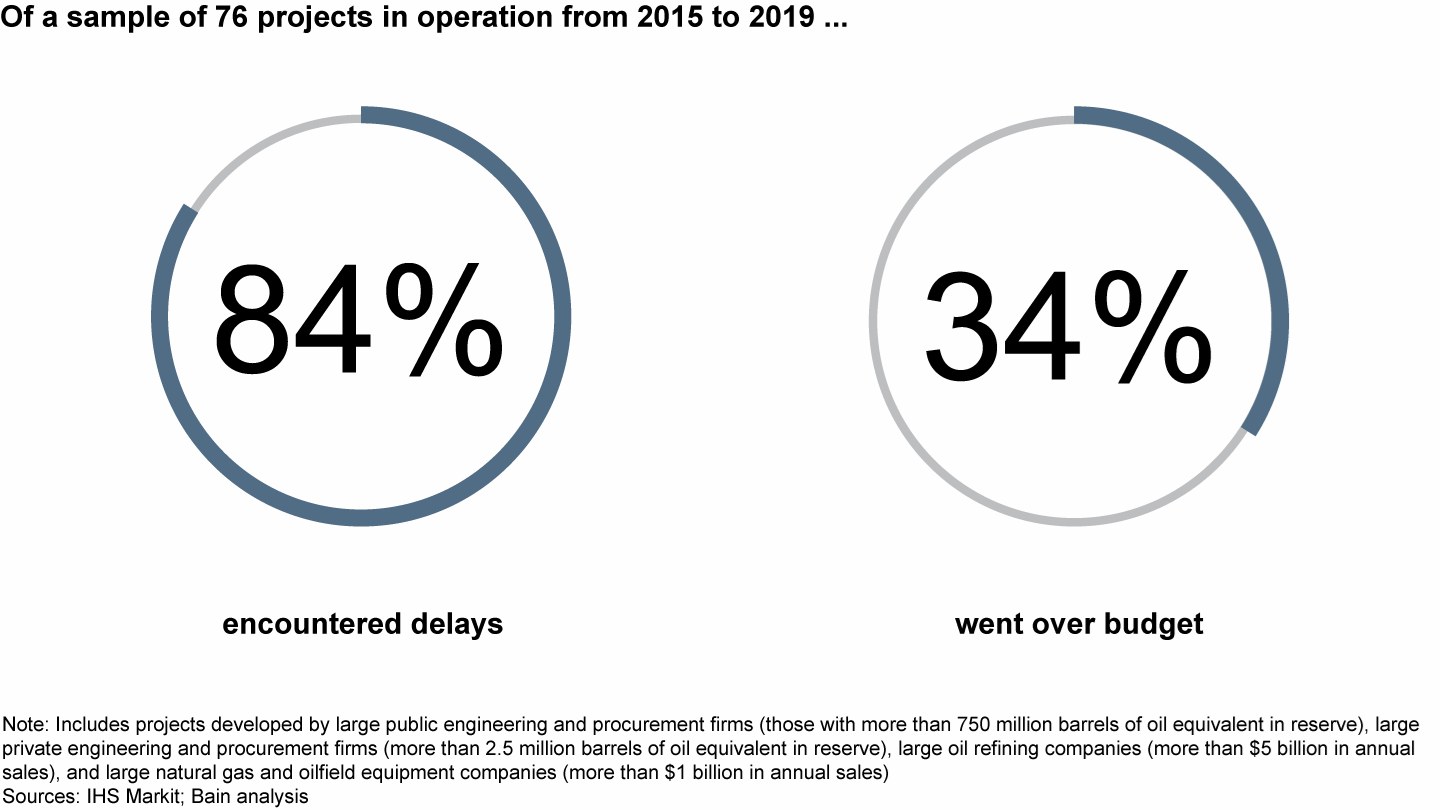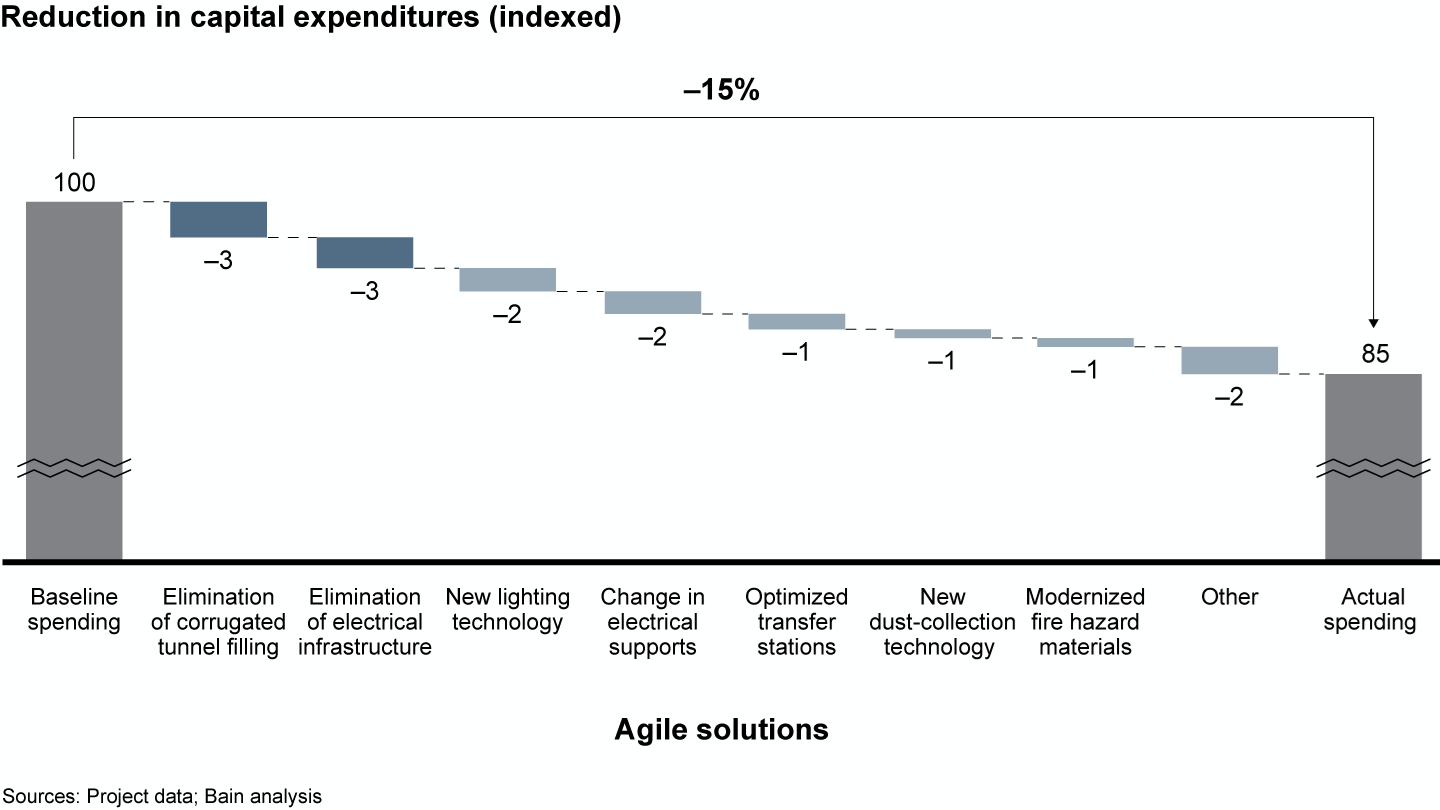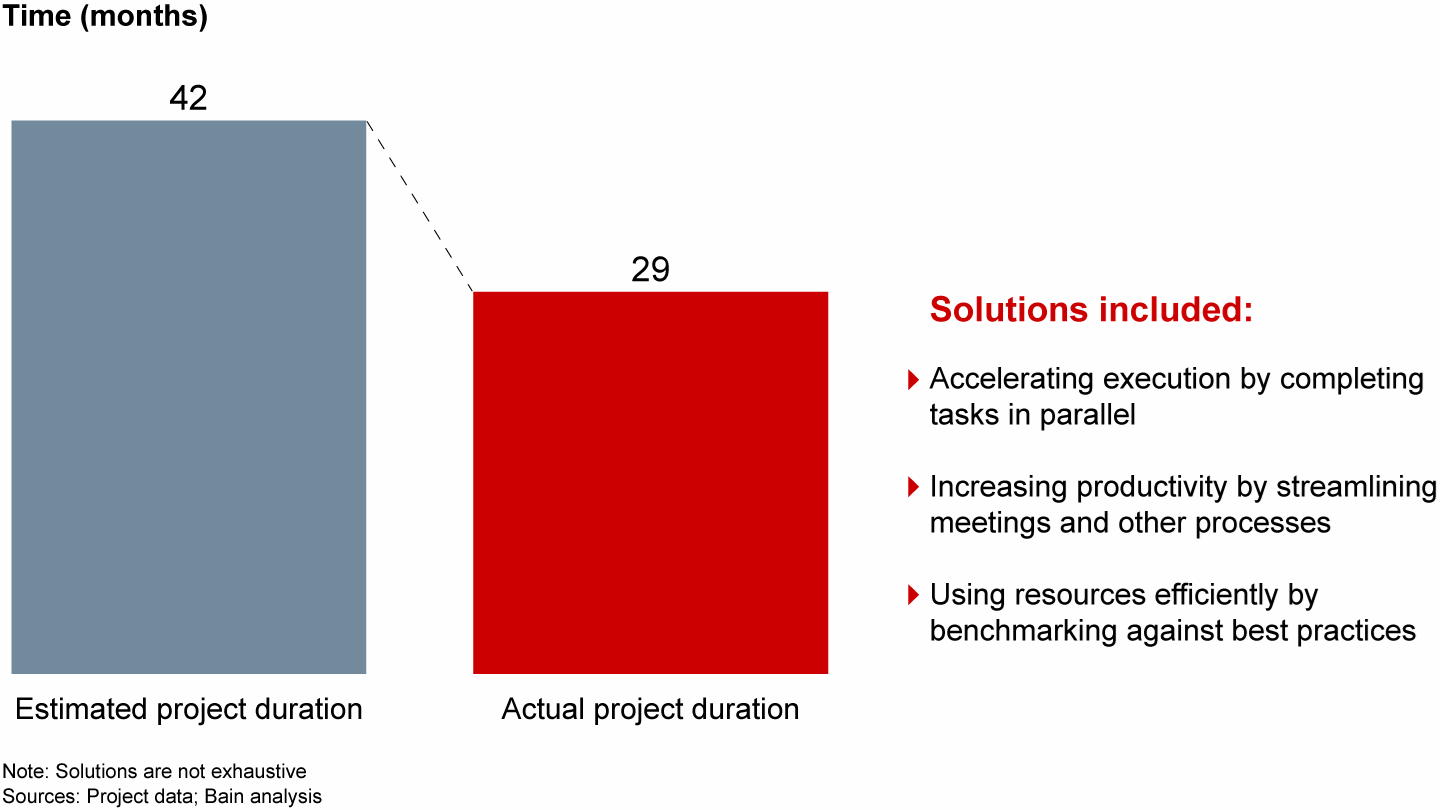Brief

At a Glance
- Major capital projects often encounter delays and run over budget.
- Companies are increasingly incorporating digital technologies and Agile approaches to try and improve project outcomes.
- Leading firms are targeting these tools at the sweet spots where significant value is at stake and traditional tools now fall short.
In many cases, CEOs, CFOs and other executives will retire before their multibillion-dollar capital projects come to fruition. Energy and mineral resource development, chemical and processing plants, infrastructure and other capital-intensive projects can take years or even decades to complete, frequently plagued by cost overruns and delays.
But what if executives could meaningfully shrink timelines and deliver results from capital projects on their watch—thereby cementing their legacies?
The scope of the challenge is vast. Take the oil and gas industry, in which 34% of capital projects go over budget and 84% encounter delays, according to Bain & Company analysis of IHS Markit data (see Figure 1). The average delay is about two-and-a-half years, and about 20% of delayed projects extend five-plus years beyond the initial estimate. That’s five-plus years of foregone cash flow from the development, often enough to kill the return on capital. The troubles can span the entire project life cycle, from developing a flawed design concept in the early stages, to struggling to manage construction activities in the late stages.
Many oil and gas capital projects encounter delays and go over budget, leaving significant money on the table


Executives believe they can curb the problems. More collaboration between project owners, service providers and other partners could be part of the answer. But capital projects are a difficult environment in which to make change. There are significant risks involved; large amounts of value at stake; complex, cross-functional capabilities required; complicated joint venture partner requirements often in play—and it’s all governed by regimented, tried-and-tested management processes.
In seeking fresh ways to improve project outcomes, leadership teams in capital-intensive industries are beginning to recognize the power of incorporating proven digital technologies and Agile practices. These tools can help reduce costs and accelerate the speed at which projects are completed and start to generate revenue.
Still, it’s early days, and in the rush to adopt these new tools, companies sometimes apply them in a haphazard or misguided way.
Leading companies are taking full advantage of digital solutions by applying the right tools where the most value is at stake, increasingly in the early phases of the project. And in the later stages, they’re finding opportunities to scale up the use of effective digital tools.
Leaders also know where the application of Agile methodologies can deliver the biggest improvements in outcomes: by accelerating the necessary collaboration between stakeholders and generating valuable solutions much faster than traditional project management processes would. For most businesses, that means running Agile teams for tasks such as critical-path planning and acceleration, improving capital efficiency and speeding up project execution, while keeping the rigorous, traditional approach for the rest of the project.
Above all else, the message is simple: Value is king. Leading firms view digital tools and Agile methodologies through the lens of value—whether it’s time to first production, capital expenditures, return on capital, risk or other measures—and tailor their use accordingly.
No time to waste
Capital-intensive industries have been among the slowest businesses to deploy digital tools, and companies that have implemented them tend to apply them first to their operations. That’s a missed opportunity, because digital technologies focused on the right project activities can accelerate completion of capital projects and help reduce their costs.
There are digital solutions applicable to every stage of capital projects. But companies typically incorporate them later in the project than they should, often not until the execution phase, which lessens their potential positive impact.
Leading companies are taking advantage of the latest digital technologies from the beginning of the project, when there are more degrees of freedom and variables that can be influenced. Making the right decisions at this point can deliver substantially higher value compared with choices made at later stages.
Artificial intelligence (AI) has emerged as one of the most important digital tools in this area. Companies are using AI-enabled software to run simulations on hundreds or thousands of design concepts to try to predict the most effective ones—an undertaking no team of humans could feasibly accomplish. These are often the choices that are most fundamental in determining the project’s future value: for example, underground vs. open-pit mining; choosing the optimal pit shell, mining sequence and processing plant design; or even deciding not to develop at all. Although these choices involve creative, commercial and engineering thinking normally entrusted to humans, machines are proving useful in augmenting people’s capabilities.
Consider a high-speed rail project in China. Taking mapping and geological data and images of the area, the project team used software and virtual reality (VR) tech to simulate the best train route and optimal tunnel design and to automate portions of the bridge design process. The team used 3D printers to quickly make model parts of the rail station and other design features, which made it easier and faster to communicate plans with stakeholders. Building information modeling (BIM) software was used to run potential collision analysis, helping avoid construction problems and save money.
Ultimately, VR and 3D printing helped reduce the rework rate by 10%, and the team designed 6 tunnels and 10 bridges in six weeks—markedly faster than the several months this would typically require.
Leading mining and oil and gas companies are also making progress using BIM, visualization and “digital twin” software on engineering and design tasks. Early results are promising, with examples of 40% to 50% reduction in engineering effort observed so far, and significant reduction in capital expenditures and project execution timelines anticipated. Opportunities to integrate design, as-built, time and cost data are on leaders’ roadmaps.
On the other end of the project life cycle, companies sometimes struggle to scale up their use of technology during the execution phase. The problem could be trying to slot in too many digital solutions, or perhaps the most valuable solution doesn’t get broadly used. Whatever the reason, ineffective scale-up of digital technologies results in wasted investments, confused and frustrated workforces, and foregone value.
Leading firms succeed in scaling up digital tools by prioritizing the most important factors that determine value. Second, they focus on digital solutions that can be feasibly deployed by their workers and incorporated into their workflows rapidly and with minimal disruption.
For instance, an oilfield services provider saw an opportunity to boost worker productivity during the execution phase—a crucial factor in the project’s value, considering thousands of people were involved. Some companies use radio-frequency identification chips and biometric technology to track worker movement on construction sites, but the oilfield services firm recognized that by combining these tools with mobile apps and data analytics it might be able to better manage workflows and improve outcomes in project quality, speed and safety.
The company started by digitizing worker guidelines and standard protocols, such as logging supervisor approvals, for a few job functions at one site. The firm then gradually expanded the effort. It switched from a paper-based system to using mobile apps to manage the workflows for repeatable tasks within select procedures, including logging task completions, interim approvals and safety checks. This created useful digital trails, ensured adherence to procedures and allowed the company to identify inefficiencies. The new digital approach demonstrated its worth, and the company decided to further scale its use. Over the course of two years, it deployed the system across 12 product lines and more than 10,000 workers at jobsites in 50-plus countries.
The result? The company managed to reduce its workforce’s nonproductive time by a factor of 10.
Finding Agile’s sweet spots
Like digital products, Agile methodologies are now having a powerful impact on capital project outcomes when focused on value. For example, applying Agile in a targeted manner to bottlenecks in capital projects can improve capital efficiency and significantly accelerate progress in critical areas.
It’s difficult to pull that off, of course, because Agile methodologies feel antithetical to capital project management in many ways. These projects are complex and risky, tend to have large sums of money at stake and go on for long periods of time. Over the years, companies have developed strictly regimented processes for managing them (for good reason).
Those rigorous processes have enabled successful completion of increasingly complicated capital projects, but along the way, they have sometimes become impediments that can add to a project’s complexity, reduce efficiency and discourage innovation. For example, creating and integrating a single improvement to current planning assumptions might become its own process, requiring a new manual exceeding 100 pages. It can be even worse if the enhancement requires interaction with external service providers to validate it. That level of process prescription quickly discourages project teams from suggesting improvements at all.
Cross-functional teams working with Agile disciplines could provide the answer. Early adopters in major energy and resources capital projects have found success by applying the methodologies to the highest-value challenges, where such practices can make a difference—and quickly.
For example, a mining company enacted Agile sprints—assigning a cross-functional team a specific task to complete within a short, defined time period—that lasted one to four weeks during the planning and design phases of two projects. In one focused on improving an underground conveyor-belt system, the Agile team identified opportunities to reduce the scope of the project and enhance engineering to capture more value. The ideas included removing unnecessary corrugated tunnel filling and electrical infrastructure and deploying new lighting and dust-collection technology. The solutions helped decrease capital spending on the conveyor-belt improvements by roughly 15% (see Figure 2).
An Agile team’s ideas reduced costs by 15% on a conveyor-belt improvement project


In the other project, an Agile team was tasked with finding ways to shrink the timeline for constructing an underground conveyor belt. The team rapidly generated tactics to accelerate execution, including completing some key construction tasks in parallel; increasing productivity by streamlining meetings, shift changes and travel to and from meals; and using resources more efficiently. For example, benchmarking against best practices in other capital projects helped trim the number of hours required to build the conveyor belt’s foundational structure by about 17%. These ideas helped reduce the conveyor-belt construction timeline from 42 months to 29 months (see Figure 3). Why was this so important? Because this conveyor-belt project was on the critical path for the overall mine development project, so the entire timeline was accelerated as a result.
An Agile team’s solutions shrank a conveyor-belt construction project timeline by 31%


Agile methodologies aren’t well suited to solving every problem, and assigning teams to the wrong tasks can waste resources. Why did Agile work in the examples above? It’s because of three characteristics:
- A significant amount of value was at stake.
- The challenge (or part of it) could be resolved quickly.
- Cross-functional input was necessary to identify solutions.
A key takeaway: Companies have little to lose by trying out Agile sprints on valuable problems, as the cost in time and resources is immaterial to the project’s bottom line. It’s worth at least giving it a shot.
And experimenting with Agile doesn’t mean project owners have to throw out their tried-and-true project management processes, such as the stage-gate model of decision making. Leading firms have substantially accelerated the delivery of value in capital projects by implementing Agile methodologies in parallel to their rigorous, default project-development processes.
Where are the service providers?
Engineering, procurement and construction (EPC) service providers and managers are perhaps best positioned to bring digital tools and Agile methodologies to bear on capital projects, thanks to their experience working on a variety of projects with customers across different geographies. But EPC service providers are also struggling to deploy and systematize best practices, in part due to the complexity and unique characteristics of each capital project. Furthermore, identifying the right mix of digital technologies isn’t a straightforward task: Such products typically only address a particular piece of the capital project life cycle or a specific industry, and most digital tools don’t integrate easily with one another.
Successfully implementing digital and Agile solutions in capital projects will require proactive collaboration throughout the endeavor between project owners and their contractors, subcontractors and partners.
Forming a game plan
When applied in smart, targeted ways at the right parts of a capital project, digital technologies and Agile methodologies have the potential to address the chief challenges in delivering capital projects on time and on budget.
Although the prospect may seem daunting at first, leaders can take steps to unlock the most value from these endeavors. To start, project directors and steering committees should ask themselves the following questions:
- What are the three most critical and controllable factors that will determine the value for this project, such as the timeline for initiating production? What other business challenges, such as talent scarcity and carbon footprint, are likely to get in the way?
- How might existing digital tools help us address our most critical business problems and opportunities to increase value? How can we build early confidence (or not) in their value and scalability for our project?
- By the time the project is completed, what digital solutions or optionality will be important for the operating asset? How do we prudently build in readiness during the project phase?
- Where might cross-functional teams working with Agile methods on a short deadline be able to add value, accelerate progress or assure delivery in this project?
- How can our partners (joint venture partners, service providers and contractors) help? How can we help them?
Meanwhile, leaders at service provider firms can consider questions such as these:
- How can we use digital technologies to improve the quality, speed and cost of our current offerings? Are there opportunities to use digital products to expand our offerings, such as moving into life-cycle cost management?
- How might digital tools and Agile methodologies help us address the age-old need for better collaboration along the supply chain?
- Are there ways digital technologies and Agile methodologies could help us address the long-term needs and challenges of our customers, such as talent scarcity and demand for more sustainable capital projects?
- How do we manage the risks of implementing digital technologies and Agile methodologies?
Brian Murphy, a Bain & Company partner based in Perth, leads the firm’s Energy & Natural Resources practice in Asia-Pacific. Neelam Phadke is the practice director with Bain's Energy & Natural Resources practice in Asia-Pacific; she is based in New Delhi.
The authors would like to thank Sara Pereira for her contributions.